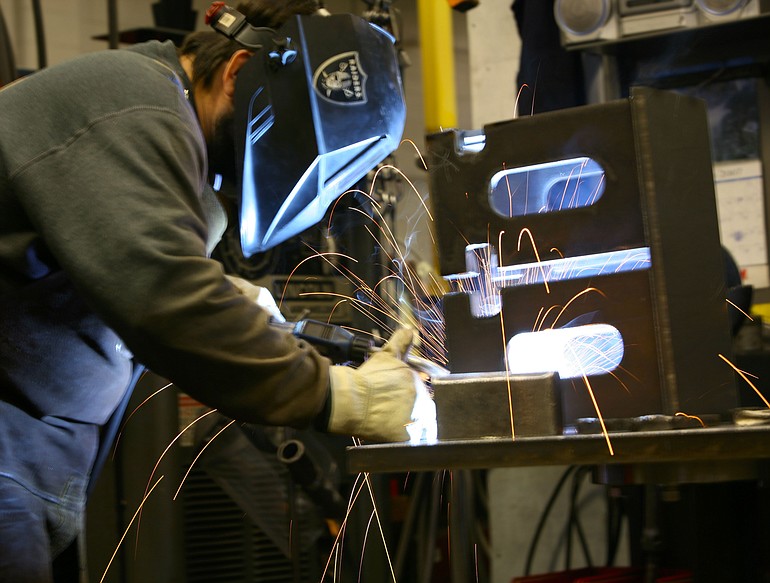The U.S. manufacturing sector posted its 10th straight month of expansion in May — a development that bodes well for employment in Clark County, a regional labor economist said Tuesday.
“We are seeing some of that uptick in manufacturing already here,” said Scott Bailey, Southwest Washington regional economist for the state Employment Security Department. “It looks like it should continue to be a positive factor for the near future.”
That’s good news for a county suffering from a jobless rate of 13.7 percent. Bailey cautioned, however, against using the report released by the Institute for Supply Management Tuesday to predict a local turnaround.
The institute, a trade group of purchasing executives, said its manufacturing index dipped slightly in May from a nearly six-year high in April. But the 59.7 reading for May was well above the 50 level that indicates expansion. Meanwhile, export orders rose last month despite the debt crisis in Europe that threatens to spread.
Bailey said the positive news for manufacturing stems partly from “pent-up demand” and partly because “things are doing a little better. Whether this is sustainable or not, we’ll see.”
At the same time, Bailey said, the national numbers show “the expansion in manufacturing is pretty broad-based, so it’s not a high-tech thing. It’s pretty much an across-the-board thing.” As a result, Bailey said he would expect to see in Clark County “a little more uptick in metal fabrication and machines, and maybe transportation equipment and maybe plastics.”
A broad-based expansion in manufacturing could positively affect Clark County manufacturers, such as Vancouver-based Columbia Machine Inc. The worldwide supplier of automated equipment that places goods on pallets and concrete products-making machinery and systems.
Bryan Goodman, vice president of manufacturing operations for Columbia Machine, said Tuesday that he is “cautiously optimistic” about the possibility of a sustainable economic recovery. “It’s really tough,” Goodman said, recalling when the recession dug in its heels two years ago. “We took such a drop on the construction-related part of our business.”
Nevertheless, Goodman said, Columbia Machine’s domestic business has stabilized while its international business has experienced a boost stemming from growth in Latin America, Eastern Europe and India. Goodman said his company also has experienced “a good pop in additional sales” in the Portland-Vancouver area from a new manufacturing services division it launched in 2009 that offers contract manufacturing and support services.
Long dry spell
In Clark County, the economic bright spots to date have been few. The county added 500 jobs in April, reducing the county’s jobless rate to 13.7 percent from a revised 14.6 percent in March. But those jobs reflected seasonal factors such as increased construction activity in spring rather than a fundamental increase in job growth, according to Bailey. April’s job gains, while not a fundamental sign of job growth, ended a nine-month drought: The last time Clark County added jobs was in July 2009, when it posted a gain of about 500 jobs.
The county’s construction industry remained sluggish in April, shedding 100 positions. Certain segments of the county’s manufacturing industry, however, grew that month: The electronics manufacturing industry, for example, added 100 jobs for the second month in a row, according to Bailey, and wood products generated 100 jobs.
Washington state has, overall, fared better than Clark County: The state’s jobless rate went from a seasonally adjusted 9.5 percent in March to 9.2 percent in April. Nationally, the economic recovery gained strength on the biggest rise in construction spending in nearly a decade and the 10th straight month of expansion for the manufacturing sector.
Temporary government incentives fueled most of the construction spending increases in April. Industry spending rose 2.7 percent with gains in all major sectors, the Commerce Department said Tuesday. Meanwhile, export orders rose last month despite the debt crisis in Europe. “The European fiscal crisis doesn’t appear to have harmed the prospects of U.S. manufacturers, at least not yet,” wrote Paul Ashworth, senior U.S. economist with Capital Economics.
Construction spending was boosted by a home buyer tax credit, which helped residential construction surge 4.4 percent in April. The tax credit expired at the end of April.
Government spending also rose on the strength of federal support. The 2.4 percent increase was aided by the economic stimulus program that Congress passed in February 2009. State and local spending jumped 2.3 percent and federal spending rose 2.9 percent.
The other major sector, nonresidential construction, climbed 1.7 percent. That marked the first advance in this category since March 2009. The strength in April came from gains in private sector work on communications projects and power generation facilities. Construction of office buildings and the category that includes shopping centers fell in April.
Commercial building projects have suffered in the weak economy through rising loan defaults and tighter credit. That has made it harder for developers to get financing.
Ian Shepherdson, chief U.S. economist at High Frequency Economics, said the spike from the home buyer tax credit is likely to fade now that it has expired.
He discounted the unexpected rise in nonresidential activity and said it could possibly be revised away next month.
“These numbers are hugely unreliable … and we expect a downward revision next month,” he said.
Hope for housing
Home builders have expressed optimism that construction will keep improving even with the expiration of the home buyer tax credits.
Luxury home builder Toll Brothers Inc. reported last week that it had a narrower loss in its latest quarter and had seen a surge in new home orders. The company said the strength in orders was holding up in May even though the home buyer tax credits had come to end.
PulteGroup Inc., the nation’s largest home builder, reported in early May that it had been able to reduce its loss for the first quarter and expected to be profitable this year. That would mark a major turning point for the company, which has posted losses in 14 consecutive quarters.
In the manufacturing report, the group’s employment index, which measures employers’ willingness to hire, rose 1.3 percentage points to 59.8. That was the highest level since May 2004.
New orders, a gauge of future production, were unchanged at 65.7.
“We haven’t lost much in the way of momentum,” said Norbert Ore, chairman of the ISM’s manufacturing survey on a conference call. “The manufacturing sector continues to move ahead.”
The Associated Press contributed to this story.




